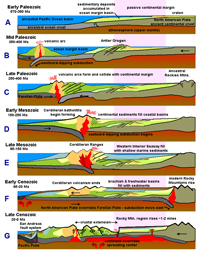
Regional Geology of North America |
North American Cordillera |
Click on images for a |
| The entire region west of the Great Plains is collective lumped together and are called the Cordilleran Ranges, part of the great chain of mountains that border the Pacific Ocean from Alaska to South America. The North American Cordillera is subdivided into the Eastern Cordilleran Ranges (which include the Rocky Mountains) and the Western Cordilleran Ranges (which include the Coast Ranges, Cascades, and Sierra Nevada)(see Figure 1). |
Evolution of Western North AmericaThe following brief synopsis of the geologic evolution of the western half of North America is perhaps the best way to start an examination of the physiographic regions of the western United States (Figure 105).At depth, ancient crystalline basement rocks of Precambrian age underlie most of the United States. Crust that had assembled into the stable cratonic shield in Precambrian became foreland basins where sediments accumulated across much of Midwest and Great Plains. At the same time, sediments spread accumulated in the Pacific Ocean margin basin (Figure 105A). In the early Paleozoic Era, shallow seas transgressed and retreated several times onto the stable continental foreland. Thick packages of sedimentary rock, mostly marine limestones, accumulated across much of what is now the western United States. By Mid Paleozoic time the western foreland margin began to undergo tectonic changes with a mountain-building event called the Antler Orogeny (Figure 105B). The Antler orogeny impacted the impacted the continental margin region beginning in Late Devonian and continuing into early Pennsylvanian time. The orogeny impacted what is now the Nevada region, but the effects may have been more widespread. The mountain building continued to migrate eastward during the Laramide Orogeny. The Laramide Orogeny occurred in a series of pulses of uplift and volcanism that impacted the greater Rocky Mountain Region between about 80 million to 35 million years ago (Figure 105F). Laramide mountain building overlapped the Sevier mountain building further west. Current thought is that North America overrode the Farallon Plate at a rapid pace and a low angle, disrupting subduction or moving it further east. Sediments from Laramide ranges gradually filled in the Western Interior Seaway basin. In late Cenozoic time, North America began to override the spreading center that formed the boundary between the Farallon Plate and the Pacific Plate (Figure 105G). As the spreading center as moved eastward under North America, crustal compression changed to crustal extension, resulting in the opening of formation of the Great Basin and Basin and Range structural regions. Sub-crustal heating resulted in the regional rise of the entire region including the Rocky Mountains, Colorado Plateau, and western Great Plains. |
 Fig. 105. Generalized geologic evolution of western United States from Late Precambrian time (1 billion years) to the present. |
 Fig. 106. General types of mountains found in the western United States included tectonic mountains (folds, faults), erosional mountains, volcanic mountains, and complex combinations of all kinds. |
| https://gotbooks.miracosta.edu/geology/regions/cordillera.html 1/20/2017 |